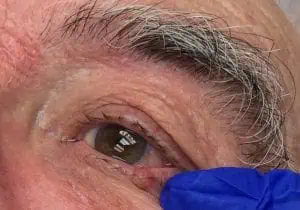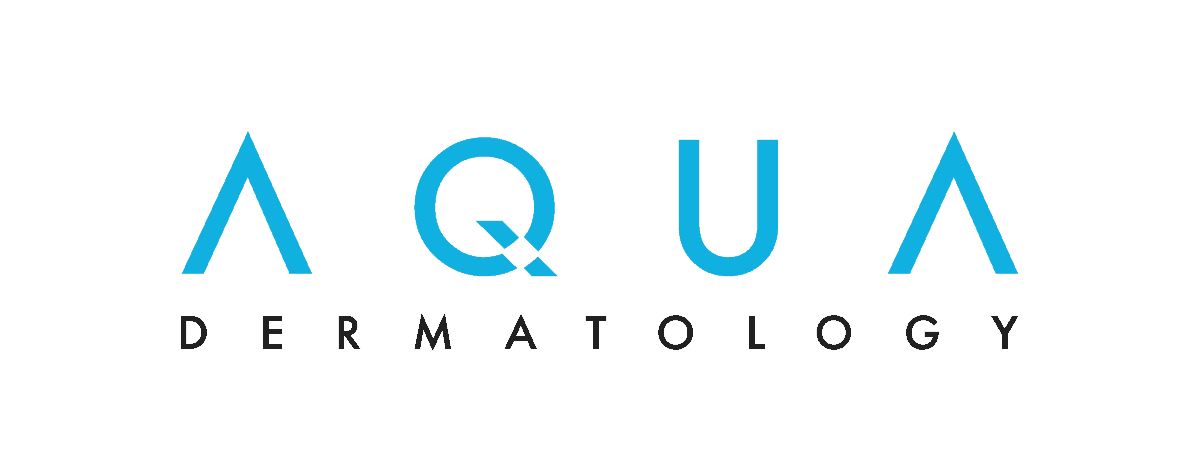 When you hear “cancer,” eyelid cancer probably isn’t the first type that springs to mind. Maybe you didn’t even know it existed. But skin cancer on the eyelid is common, accounting for up to 10 percent of all skin cancers. If you think about it, it’s not so surprising — eyelid skin is very thin and sensitive, and unless you wear a hat and/or sunglasses, it gets a lot of sun.
When you hear “cancer,” eyelid cancer probably isn’t the first type that springs to mind. Maybe you didn’t even know it existed. But skin cancer on the eyelid is common, accounting for up to 10 percent of all skin cancers. If you think about it, it’s not so surprising — eyelid skin is very thin and sensitive, and unless you wear a hat and/or sunglasses, it gets a lot of sun.
“Eyelid cancer is directly related to sun exposure,” said Dr. David Herold, a board-certified radiation oncologist at Water’s Edge Dermatology who specializes in treating skin cancer. Anyone can get eyelid cancer, but it’s more common in fair-skinned people over the age of 50. “Lighter-colored skin has less melanin to help block out damaging UV rays,” Dr. Herold explained.
There are two common types of eyelid tumor. Most are basal cell carcinomas, slow-growing cancers that rarely spread to other parts of the body. They are generally easy to treat, and the chance of recurrence is usually very low. The other nonmelanoma eyelid cancer is squamous cell carcinoma. This type of cancer can spread, but it’s easily treated if caught early. Melanoma, one of the most dangerous types of skin cancer, makes up only 1 percent of eyelid cancers.
Early detection of eyelid cancer is important because the cancer can grow into deeper layers of the skin and potentially cause disfigurement. “Anything near the eye needs to be taken care of as soon as possible,” said Dr. Herold. “We’ve had some cases where the cancer had grown for 10 years and wrapped around the eye socket.”
When eyelid cancer is detected early, there’s a better chance of removing it completely and minimizing the amount of tissue that needs to be removed.
Eyelid cancer symptoms

“Eyelid cancer typically presents as a painless, flesh-colored or pinkish bump,” said Dr. Herold. Sometimes the bump bleeds — for instance, you may scratch it in your sleep — and it can develop a crust or scab.
Other symptoms of eyelid cancer include:
- Roughness or thickening of the eyelid skin
- Change in the eyelash pattern or eyelash loss. “The cancer often occurs in the hair-bearing area of the eyelid,” said Dr. Herold. “Sometimes people notice when they’re applying mascara that eyelashes are falling out or there’s a patch of eyelashes missing.”
Skin cancer can occur anywhere on the eyelid, including the inner and outer corners of the eyes, but it’s most common on the lower eyelid. “The upper eyelid seems to be protected by the eyelashes,” said Dr. Herold. “It’s like they’re holding a hat over the area.”
Diagnosing eyelid cancer
Basal cell carcinoma (BCC) can grow very slowly, so oftentimes, the skin cancer has been there for months or even years when it’s diagnosed. “I’ve had many patients say, ‘I’ve had this benign cyst and it’s been looked at many times by my primary care provider, but I think it’s a little bigger,’” said Dr. Herold. “Lo and behold, it’s a BCC.”
If the growth looks suspicious, the dermatologist may perform a biopsy. During this quick procedure, the area is numbed and a sample of the tissue is removed. It’s then sent to the pathology lab for examination under a microscope. (Water’s Edge Dermatology has an in-house pathology lab with a dedicated lab team and a board-certified dermapathologist who provide a thorough review and a fast turnaround on results.) If the diagnosis is skin cancer, the doctor then discusses treatment options with you.
Eyelid cancer treatment options
Eyelid cancer is typically treated with surgery or radiation.
Mohs surgery
The most common treatment for nonmelanoma eyelid cancer is Mohs surgery, a procedure that’s done in stages. The surgeon removes a thin layer of tissue, then examines it under a microscope to see whether it contains cancer cells. The process is repeated until no more cancer cells are found. This approach spares healthy tissue and minimizes scarring.
A highly skilled surgical team may also perform Mohs surgery on certain eyelid melanomas. Others require traditional surgical excision.
Electron beam therapy
For delicate areas like the eyelids, where surgery can be challenging and often requires reconstructive surgery afterward, a form of radiation therapy called electron beam therapy (EBT) can be especially useful. EBT uses a very thin electron beam to destroy cancer cells in the targeted area while avoiding healthy cells. The beam stops at the skin, which helps limit side effects to organs and body tissue.
“It’s a gentle, painless way to treat eyelid cancer,” said Dr. Herold. “It effectively melts away the cancer.”
With EBT, you receive daily treatment for three to six weeks. Each treatment takes just two minutes. After about two weeks, the cancer is approximately 50% smaller; over time, it completely flattens out and disappears. The cure rate with EBT is more than 95%.
How to prevent eyelid cancer
Sun exposure is the enemy of eyelids (and the rest of the skin). To help prevent eyelid cancer, “sunglasses and hats are your best friends,” said Dr. Herold. In both cases, bigger is better. Opt for large, wraparound sunglasses to filter light entering from either side. Choose sunglasses with 100% UVA/UVB protection. A broad-brimmed hat, ideally at least 4 inches wide, also helps protect your eye area.
People tend to forget their eyelids when it’s time to apply sunscreen — and that’s a mistake. But choose your product carefully. “Sunscreen can burn your eyes,” said Dr. Herold. Sunscreen sticks are less likely to run into the eyes. In addition, dermatologists often recommend mineral sunscreens that contain zinc or titanium, which adhere to the skin better than chemical sunscreens.
Article Written By: Karyn Repinski, a Brooklyn, NY-based award-winning health and beauty writer
Medical Review By: David Herold, MD, MBA





